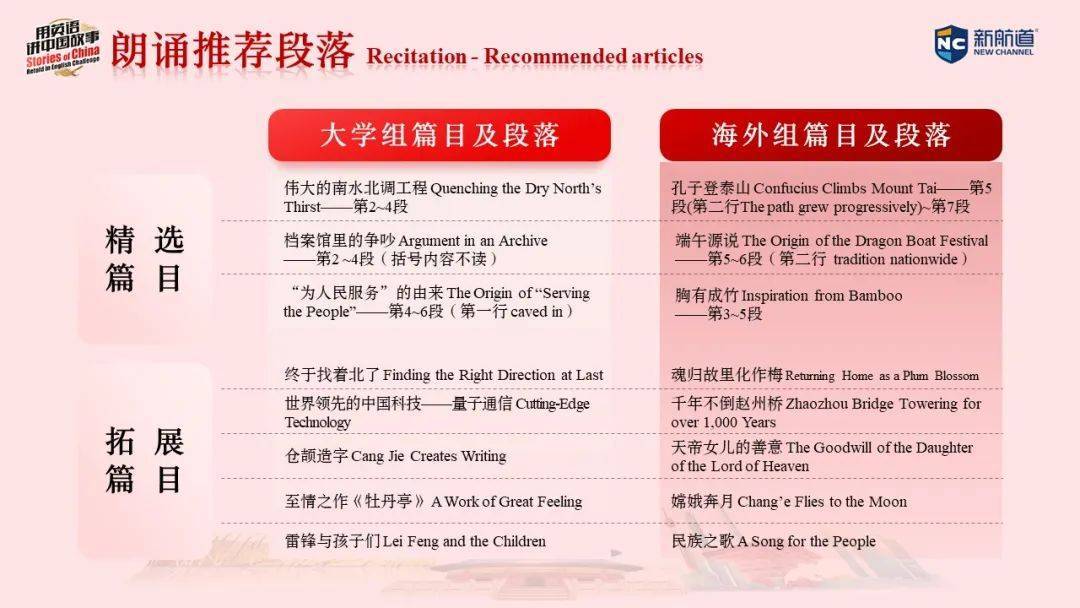
8月21日,由中国教育电视台与新航道国际教育集团联合主办的第三届“用英语讲中国故事”活动在天津师范大学启动。

主办单位:中国教育电视台、新航道国际教育集团
指导单位:中外语言交流合作中心、中国教育报刊社、中国教育国际交流协会、天津市委网信办、天津市教委、天津市外办
冠名合作方:中国银行、万事达卡
协办单位:世界汉语教学学会
启动仪式承办单位:天津师范大学
分区承办单位:新航道全国分校、新航道前程留学全国分公司
用英语讲中国故事,顾名思义——选手们展示的既有耳熟能详的故事,也有脍炙人口的古诗,这些都是中华文化绝佳的表达方式。






而在实际交流中,把它们中规中矩地说给外国人,就算大功告成了吗?
貌似还差一点火候。
因为许多故事背后,还藏着许多同样精彩的“花边秘闻”,更利于听众的记忆,错过了实在有点可惜。
那么,如何他们挖掘和讲述出来呢?
下面,咱们就拿几篇荐文来给大家抛砖引玉~
中西对比
想让外国朋友把中国故事记得更瓷实,一个颇为行之有效的方法,就是在中国故事和外国文化、历史之间建立联系。
比如,黄河就能与西方人熟悉尼罗河(Nile)对应上:它们对于当地文明古国而言,都是“母亲河”。
A long, long time ago, our ancestors wanted a place to settle down. They found that the soil along the Yellow River was fertile, the climate was mild and that the river provided a a source of water. It was a place very suitable for growing crops, and so they settled down there, as the ancient Egyptians settled down along the Nile.
很久很久以前,我们的祖先想要找一个固定的居住地方,他们发现黄河边上土壤肥沃、气候温和又有水源,很适合种植各种农作物,便在此定居下来,就像古埃及人沿尼罗河定居一样。
——改编自《用英语讲中国故事》(基础级)
有关黄河的一则日记
如此一来,黄河就被打上了“东方的尼罗河”这个标签,其重要的历史地位自然更容易被外国听众理解了。
建立文化关联并不局限于找共通点,同样还能“反其道而行之”,找一些对比鲜明的不同之处。
比如,我们介绍完了中秋,就可以聊聊中西方在“月文化”上的南辕北辙。
As an auspicious symbol in China, the moon has always been representative of family reunion. On the flip side, in western countires, it sometimes also represents the negative associations -- illusion, confusion, and deception.
在中国,月亮向来是个吉祥的符号,寓意阖家团圆。而在西方国家,它有时还带着负面联想,例如幻觉、迷惑以及欺骗。
正如我们通过“橘生淮南则为橘、生淮北为枳”这句古话了解到一个可有可无的植物学知识那样,很多时候,反差或对比也可以形成一种记忆点。
无论共性还是特异,透过这种比对和联系,听众将从中国故事中体会到和而不同的文化魅力。
古今差异
中华文化源远流长,发展到不同的年时代或朝代,均有着各自的特性。
所以,对于初步了解中国的外国朋友,咱们不妨把故事的内容放在时间轴上,通过古今对比,话说得深些,大家也好懂得透些、记得牢些。
先拿小学低年级组的古诗荐文《九月九日忆山东兄弟》为例,它的标题就很有说头。
The title of this poem is generally translated as "On the Mountain Holiday Thinking of My Brothers in Shan Tung" in English. "Shan-Tung" is Wade-Giles romanization of "Shan Dong", refering to a province located in the north of China.
这首诗的英文标题为“On the Mountain Holiday Thinking of My Brothers in Shan-Tung”。其中,“Shan-Tung”是“山东”的威妥玛-翟理思式的音译,指代中国的一个北方省份。
But it is woth noting that the "Shan Tung" used here, in Tang dynasty when the poet wrote this famous poem, does not refer to a certain province, and instead means the areas to the east of Mount Hua.
但是唐代诗人在撰写这一著名诗篇时所用的“Shan-Tung”,并非指代某一个省份,而是指华山以东的众多区域。
随时代而变迁的不仅是地名,还有习俗。这一点,我们可以在展示荐文《端午源说》时提及到。
When they heard about this tragedy, the common people of Chu flocked to the bank of the Miluo River to mourn. As they paced up and down beside the river, what grieved them most was the thought of Qu Yuan’s body being eaten by ignorant fish and shrimps. Then someone suggested wrapping balls of rice in leaves of the chinaberry tree, and throwing them in the river. This way, the river creatures would be too gorged to bother with the corpse of Qu Yuan.
楚国百姓听说贤人大夫屈原投江自尽,纷纷赶到汨罗江畔悼念。百姓们在江边徘徊,最担心的是水中的鱼虾肆无忌惮地啃食屈大夫的身体。这时候有人提议,不如用粽叶包裹一些饭团投入江中,这样,鱼虾就会去吃饭团,不会打搅屈大夫安眠了。
However, this story is just one version among the explanations to the origin of the Dragon Boat Festival.
不过,这个故事仅是端午源说中的一个。
Another lore, which spreaded much ealier than the death of Qu Yuan, goes that people believed that natural disasters and illnesses are common in the fifth month, thus they would put calamus, Artemisia above the doors on the fifth day of this unlucky month to get rid of the misfortune.
另一个传说流传的时间要远比屈原去世早得多:当时人们相信月份灾病频发,因此大家会在这个倒霉的月份往门上悬挂菖蒲、艾蒿,聊以祛灾。
——改编自《用英语讲中国故事》(基础级)
端午源说
除了在时间上举一反三,不少中国故事甚至还能和其他的故事产生联动,
故事联动
荐文《天帝女儿的善意》是这么描述村民们的对策的。
Just as the people were in the midst of this dilemma, an old man stepped forward, and said to them, “Since the Lord of Heaven wants to punish us with fire, the best thing for us to do is to hang up lanterns and set off fireworks and firecrackers on that day, to deceive the Lord of Heaven into thinking that the fires are already burning."
正在大家手足无措的时候,一位老人站出来跟大家说:“既然天帝要放火,大家不如在那一天都把灯笼挂上,点燃烟花爆竹,让天帝误以为人间真的着了火。
——《用英语讲中国故事》(基础级)
天帝女儿的善意
讲完这段内容,我们便可以“难为”一下听众:
What is the earlist dynasty this story could happen?
这个故事最早发生在哪个朝代?
相信不光是外国朋友会懵圈,许多中国同学也会一头雾水。其实,只要我们发现内容当中的一处细节,一切都会迎刃而解。
这个关键细节便是“烟花爆竹”。
想要制作这种高分贝的“气氛组”道具,最为关键的道具便是四大发明之一的火药。而以此为契机,我们便可以在揭晓答案的同时,将火药的故事自然而然地引出来。
Not earlier than Sui dynasty, when fire powder the indispensable component of firecrackers got invented.
In the Sui Dynasty (581-618) a man named Du Chunzi paid a call on a leading Taoist who was involved in the smelting of cinnabar.
隋朝年间,有一个人叫杜春子,拜访一位炼丹界的高人.
In the middle of the night Du Chunzi was woken by the cold wind. Without thinking, he added firewood to the stove, and by accident he knocked over some bottles and jars standing nearby. The inflammable materials in them – saltpeter, sulfur and charcoal – spilled into the cinnabar-smelting furnace, and immediately exploded with a roar, smoke and flames leaping from the furnace. In no time at all, the whole house was on fire.
杜春子半夜被寒风冻醒,于是他不假思索地往火炉里添加柴火,结果不小心碰倒了火炉旁炼丹用的瓶瓶罐罐,里面的硝石、硫黄、炭等易燃药物溅到了炼丹炉里,霎时间噼啪作响,只见炼丹炉内紫烟腾起,火焰蹿升,不一会儿整个屋子都着起火来。
After several similar incidents, people gradually came to realize that a mixture of saltpeter, sulfur and charcoal was highly inflammable, and so they called it “inflammable powder.” Later, they called it “fire powder.”
后来多次发生类似事故,人们逐渐认识到硫、硝、炭在一起很容易着火,就把它们称作 “能着火的药 ”,久而久之就成 “火药 ”了。
——《用英语讲中国故事》(基础级)
与火药有关的故事
一个话题,两个故事,可谓一箭双雕。
而从这些个示例中我们也不难看出,中国故事都绝非孤立的存在:深刻隽永的中华文化贯穿其中,让每一则故事都能够从各个角度,绽放出人文主义精神的光彩,彼此之间呼应成趣。
才华横溢如你,是否已经开始摩拳擦掌了呢?
发现中国故事的更多讲法,探索中华文化的更多诠释角度,第三届“用英语讲中国故事”活动,等待你的参与!
活动报名方式-进入官方链接进行报名↓↓↓
https://h5.storyofchina.cn/chineseStory?referrer=65948
CHN Stories 邀您共读中国故事
一起让世界更了解中国!